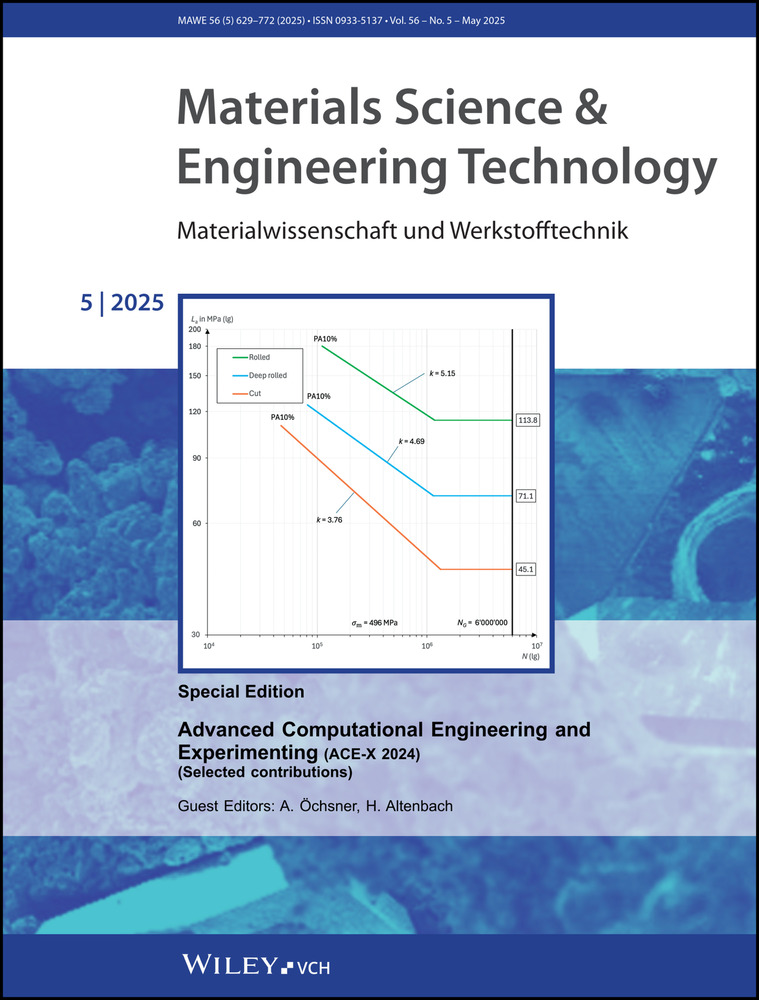Influence of Galfan coating on tensile properties, microstructure and dislocation densities of CRS 1018 steel
Einfluss der Galfan-Beschichtung auf die Zugfestigkeitseigenschaften, das Gefüge und die Versetzungsdichte von CRS 1018-Stahl
Abstract
enIn the present work, zinc-6 % aluminium alloy, Galfan, is coated through the hot dipping technique on tensile bars made from cold rolled CRS 1018 steel to study the influence of Galfan coating on tensile properties of mild steel. The tensile results indicate that Galfan coating prepared by the hot dipping process reduces the ultimate tensile strength and yield strength of the substrate, whereas the elongation at failure is significantly increased. The microstructure of the as-rolled, hot-dipping coated, and other comparing specimens is observed by optical microscopy. Nano indentation is used to evaluate the variation of dislocation densities in the tested specimens. The analyses of the hardness-depth curves obtained from the nano indentation testing implies that the dislocation density of the coated steel might be lower than that of the uncoated specimen. The thermal energy received by the steel substrate during the heating stage of the hot-dipping process should be responsible for the recovery of the substrate, which leads to the reduction in dislocation densities and the arrangement of the dislocations into lower-energy configurations. As a result, the Galfan coating increases the elongation at failure considerably with a moderate decrease in strengths.
Translation abstract
deIn der vorliegenden Arbeit wird eine Zink-Aluminum-Legierung mit 6 wt.–% Aluminiumanteil, Galfan, im Schmelztauchverfahren auf Zugstäben aus kaltgewalztem CRS 1018 Stahl beschichtet, um den Einfluss der Galfan-Beschichtung auf die Zugeigenschaften von Baustahl zu untersuchen. Die Ergebnisse der Zugversuche zeigen, dass die im Schmelztauchverfahren hergestellte Galfan-Beschichtung die Zugfestigkeit und die Streckgrenze des Substrats verringert, während die Bruchdehnung deutlich erhöht wird. Das Gefüge der gewalzten, schmelztauchbeschichteten und anderen Vergleichsproben wird mit Hilfe der optischen Mikroskopie untersucht. Die Variation der Versetzungsdichten in den geprüften Proben wurde mittels Nano- Eindruckprüfung untersucht. Die Analyse der Härte-Tiefen-Kurven aus der Nano-Eindruckprüfung deutet darauf hin, dass die Versetzungsdichte des beschichteten Stahls niedriger sein könnte als die der unbeschichteten Probe. Die thermische Energie, die das Stahlsubstrat während der Erwärmungsphase des Schmelztauchprozesses erhält, sollte für die Erholung des Substrats verantwortlich sein, was zu einer Verringerung der Versetzungsdichten und der Anordnung der Versetzungen in Konfigurationen mit niedrigerer Energie führt. Infolgedessen erhöht die Galfan-Beschichtung die Bruchdehnung beträchtlich bei einem moderaten Rückgang der Festigkeit.
Conflict of Interests
The authors declare no financial or commercial conflict of interest.
Open Research
Data Availability Statement
The data that support the findings of this study are available from the corresponding author upon reasonable request.




